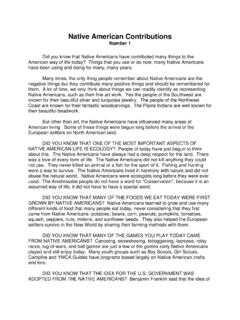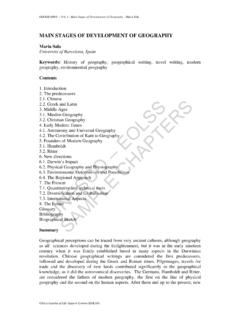Transcription of Main Stages of Development of Geography
1 Geography Vol. I - main Stages of Development of Geography - Maria Sala main Stages OF Development OF Geography . Maria Sala University of Barcelona, Spain Keywords: History of Geography , geographical writing, travel writing, modern Geography , environmental Geography Contents 1. Introduction 2. The predecessors Chinese Greek and Latin 3. Middle Ages S. TE S. Muslim Geography R. AP LS. Christian Geography 4. Early Modern Times Astronomy and Universal Geography C EO. The Contribution of Kant to Geography 5. Founders of Modern Geography Humboldt Ritter 6. New directions E . H. Darwin's Impact Physical Geography and Physiography PL O. Environmental Determinism and Possibilism M SC. The Regional Approach 7. The Present Quantitative and technical tools Diversification and Globalisation SA NE. International Aspects 8. The Future Glossary U. Bibliography Biographical Sketch Summary Geographical perceptions can be traced from very ancient cultures, although Geography as all sciences developed during the Enlightenment, but it was in the early nineteen century when it was firmly established based in many aspects in the Darwinian revolution.
2 Chinese geographical writings are considered the first predecessors, followed and developed during the Greek and Roman times. Pilgrimages, travels for trade and the discovery of new lands contributed significantly to the geographical knowledge, as it did the astronomical discoveries. The Germans, Humboldt and Ritter, are considered the fathers of modern Geography , the first on the line of physical Geography and the second on the human aspects. After them and up to the present, new Encyclopedia of Life Support Systems (EOLSS). Geography Vol. I - main Stages of Development of Geography - Maria Sala directions have developed within Geography , mainly due to the introduction of quantitative and technical tools and to the recent globalization. 1. Introduction The history of Geography is closely connected with the history of human society and its Development . It is part of human interests, and precedents can be found in all ancient cultures.
3 But as a science, Geography is relatively young and many of its fundamentals appear during the nineteenth century. For Kish Geography is as old as man's search for soil to dig for plantings, for a path that leads to water, for a trail to a place where hard rock for arrowheads may be found. But Geography is also as new as man's current search for ways to relieve urban congestion, to establish well-marked international boundaries, to describe and analyze vegetation patterns in remote parts of the earth. S. TE S. While the first geographical references are from travelers describing the landscapes and R. AP LS. the people living in them, the first scientific studies are from mathematicians and physicists interested in the environment. It can thus be said that the foundations of Geography are in the natural sciences, from the need to explain the physical environment C EO. and also on the idea of the influence of this environment on humans and society.
4 Livingstone asserts that for generations, Geography has been intimately involved in exploration , at least since the time of Muslim scholar-travelers, the voyages of the Scandinavians, Chinese, and medieval Christian adventurers. But it was with the E . european voyages of reconnaissance, during the fifteenth and sixteenth centuries, that H. this first-hand knowledge of the world contributed most decisively to coherent body of PL O. geographical knowledge of the terrestrial globe. The significance of scientific travel was mainly due to Alexander von Humboldt through his explorations in South America. M SC. The knowledge explosion occasioned by the european voyages of exploration brought new cartographic challenges and accomplishments. Although around the Mediterranean, SA NE. Portolano Sea charts had been circulating for a long time and there already existed various Mappaemundi, the new lands discovered had to be reduced to paper.
5 Gerard Mercator solved some of the mathematical problems associated with transferring a U. sphere to a flat surface with his famous map projection. In the following centuries, Geography 's close links with cartography continued to be maintained. The map, as both graphic language and visual representation, continues to be used as a geographical tool, at present with the invaluable assistance of remote sensing and Geographical Information Systems. The first work entitled Geography was written in Alexandria, in the third century , by Eratosthenes. From those beginnings the study of the earth as the home of humans, of earth processes, and of the distribution of terrestrial phenomena has continued to our day. Writings range from biblical texts and early Greek explanations to the first formal statements on Geography as a science, written between 1650 and 1850. 2. The Predecessors Encyclopedia of Life Support Systems (EOLSS).
6 Geography Vol. I - main Stages of Development of Geography - Maria Sala Chinese Kish presents several Chinese geographical writings taken from the work by Needham and Wang Ling, Science and Civilization in China. The section dedicated to earth sciences includes examples of early Chinese geographical writing. The oldest Chinese geographical document is The Tribute of Y , written during the 5th century and considered the first naturalist document in Chinese history. It is a survey of several provinces of China, including their soils, agricultural products and great rivers. Needham and Wang Ling believe it may be contemporary with the work of the Ionian geographer-philosophers. Other Chinese geographical documents are descriptions of southern regions and foreign countries, written during the first millennium of the Christian era. A much later book (fourteenth century) deals with Chinese trade with lands around the Indian Ocean and S.
7 TE S. beyond. R. AP LS. A Chinese pilgrim, Hs an-Chang, wrote on Indian cosmography and on the lands and peoples of southern Asia during the 7th century Fa'Hsien, 5th century , C EO. describes his pilgrimage travels. It has to be borne in mind that to Buddhist a travel to India is similar to the Muslims pilgrimage to Mecca. Chau Ju-Kua dealt with Chinese overseas trade and maritime expeditions of the 13th century, a book of the typo of a geographical encyclopedia E . Slaymaker, in Physical Geography , asserts that from the five types of Chinese H. Geography recognized by Needham and Wang Ling there are three that bear on physical PL O. Geography : hydrographical books and coastal descriptions (5th century ), local topographies or gazettes (4th century ), geographic encyclopedias (4th century M SC. ). In addition, the Chinese cartographic tradition, culminating in Chu Ssu-Pen's map of China (1311-1320) was significantly ahead of european work at the time.
8 SA NE. Greek and Latin The principles of geographical writing were formulated in the days of Greek and Hellenistic science. Homer's Iliad and Odyssey (9th century B. C.) are often considered U. to be the first geographical works, in the sense that they provide detailed descriptions of the people and places visited. For Kish, Hesiod's poems represent the earliest written traditions of our Greek heritage. Hesiod (8th century ) wrote about the yearly cycle in the life of Greek country folk. Works and Days has been called a shepherd's calendar, and describes the march of the seasons and the associated environmental changes. In the poem Theogony, he describes the power of the winds over the lives of men. Holt-Jensen explains how scholarly Greek writers produced topographical descriptions of places in the known world, discussing both natural conditions and the way of life of the people living there.
9 Herodotus (485-425 BC), although considered the father of history, described geographical events in a geographical setting, and some of his Encyclopedia of Life Support Systems (EOLSS). Geography Vol. I - main Stages of Development of Geography - Maria Sala writings are truly geographical in character. He not only described geographical phenomena as, for example, the annual flow of the Nile, but also attempted to explain them. In addition, he incorporated older sources of geographical information, including the existing maps. In this way Herodotus used earlier theories and descriptions which would otherwise have been forgotten. It was Aristotle, about a century after Herodotus, who produced observational evidence for a spherical form for the Earth. The scholars at the Museum in Alexandria were then able to establish the foundations for the calculation of latitude, longitude and the size of the Earth.
10 In the 3rd century , Eratosthenes (276-494, BC) made the first accurate estimation of the length of the Earth circumference with an error of only 90 km in respect to the present knowledge and has been considered as the father of scientific Geography . Of equal importance was his Development of systems of coordinates for the world, latitude and longitude, which he used to locate places and to measure distances. This made it possible for him to draw the first rather accurate map. S. TE S. R. AP LS. Hippocrates of Cos (460- 360 ), although best known for his contributions to medicine, was one of the first writers to take into account the relationship between the environment and the health and general character of men. Aristarchus of Samos (c. 3. C EO. 10-230 ) is remembered both for his practical and his theoretical contributions to Geography . He occupies a place in the history of geographical ideas for his elaboration of a heliocentric theory of the universe.
















